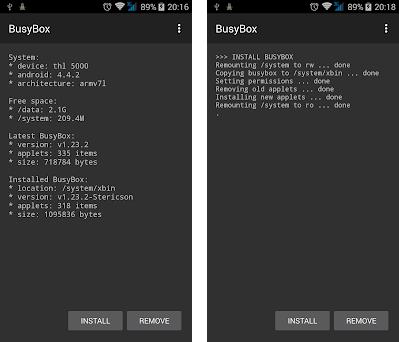
- #VERSIONS OF BUSYBOX FOR ANDROID UPGRADE#
- #VERSIONS OF BUSYBOX FOR ANDROID SOFTWARE#
- #VERSIONS OF BUSYBOX FOR ANDROID CODE#
- #VERSIONS OF BUSYBOX FOR ANDROID LICENSE#
#VERSIONS OF BUSYBOX FOR ANDROID SOFTWARE#
On about August 3, 2010, BusyBox won from Westinghouse a default judgement of triple damages of $90,000 and lawyers' costs and fees of $47,865, and possession of "presumably a lot of high-def TVs" as infringing equipment in the lawsuit Software Freedom Conservancy v. In February 2010 Samsung released its LN52A650 TV firmware under GPLv2, which was used later as a reference by the SamyGO community project. On December 14, 2009, a new lawsuit was filed naming fourteen defendants including Best Buy, JVC, Samsung and others. BusyBox and Bell Microproducts also settled out of court on October 17. Further suits were brought on Jagainst Bell Microproducts (case 08-CV-5270) and SuperMicro (case 08-CV-5269), the Super Micro case being settled on July 23, 2008.
#VERSIONS OF BUSYBOX FOR ANDROID LICENSE#
On December 7, 2007, a case was brought against Verizon Communications over its distribution of firmware for Actiontec routers this case was settled Maon condition of license compliance, appointment of an officer to oversee future compliance with free software licenses, and payment of an undisclosed sum.
#VERSIONS OF BUSYBOX FOR ANDROID CODE#
The Xterasys case was settled on December 17 for release of source code used and an undisclosed payment, and the High-Gain Antennas case on Mafor active license compliance and an undisclosed payment. On November 21, 2007, the SFLC brought two similar lawsuits on behalf of Andersen and Landley against two more companies, Xterasys (case 07-CV-10455) and High-Gain Antennas (case 07-CV-10456). The case was settled with release of the Monsoon version of the source and payment of an undisclosed amount of money to Andersen and Landley.
#VERSIONS OF BUSYBOX FOR ANDROID UPGRADE#
The lawsuit, case 07-CV-8205 was filed on Septemby the Software Freedom Law Center (SFLC) on behalf of Andersen and Landley against Monsoon Multimedia Inc., after BusyBox code was discovered in a firmware upgrade and attempts to contact the company had apparently failed. What was claimed to be the first US lawsuit over a GPL violation concerned use of BusyBox in an embedded device. In late 2007, BusyBox also came to prominence for actively prosecuting violations of the terms of its license (the GPL) in the United States District Court for the Southern District of New York. Since October 2006, Denys Vlasenko has taken over maintainership of BusyBox from Rob Landley, who has started Toybox, also as a result of the license controversies. In September 2006, after heavy discussions and controversies between project maintainer Rob Landley and Bruce Perens, the BusyBox project decided against adopting the GNU Public License Version 3 ( GPLv3) the BusyBox license was clarified as being GPL-2.0-only. Rob Landley became the maintainer in 2005 until late 2006, then Denys Vlasenko took over as the current maintainer. During this time the Linux embedded marketplace exploded in growth, and BusyBox matured greatly, expanding both its user base and functionality. As LRP development slowed down in 1999, Erik Andersen, then of Lineo, Inc., took over the project and became the official maintainer between December 1999 and March 2006. Cinege made several additions, created a modularized build environment, and shifted BusyBox's focus into general high-level embedded systems.


Since each Linux executable requires several kilobytes of overhead, having the BusyBox program combine over two hundred programs together often saves substantial disk space and system memory.īusyBox was maintained by Enrique Zanardi and focused on the needs of the Debian boot-floppies installer system until early 1998, when Dave Cinege took it over for the Linux Router Project (LRP). Since that time, it has been extended to become the de facto standard core user space toolset for embedded Linux devices and Linux distribution installers. Originally written by Bruce Perens in 1995 and declared complete for his intended usage in 1996, BusyBox initially aimed to put a complete bootable system on a single floppy disk that would serve both as a rescue disk and as an installer for the Debian distribution.


 0 kommentar(er)
0 kommentar(er)
